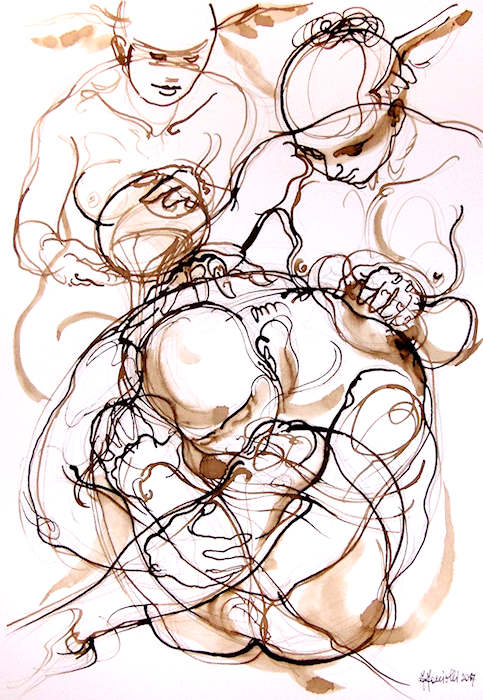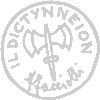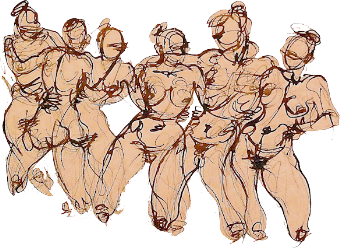Odysseus (Ulysses) meets Nausicaa and her maids
on the island of the Phaeacians
Perhaps the most ancient literary mention of Odysseus is to be found in Homer’s Iliad, which dates back to the 9th century B.C. Numerous epithets are used there to describe him: Laerziade (son of Laertes), ‘astute’, ‘of great cunning’, ‘luminous’, ‘divine’, etc. However, the most interesting epithet is that Hesiod uses in his Theogony (line 1012), where he is described as “patient,” (steadfast) as having a “a heart that bears things” (ταλασίφρονος). In the Odyssey, in fact, it seems that this hero does little else than weep and suffer, bearing things with “patience”.
 His name 'Οδυσσεύς (Odysseùs) seems to mean ‘The Sorrowful One’, from the word οδύνη (odìne = pain, sorrow, torment); from a certain point onwards, that name probably also took on the meaning of ‘The Traveller’, from the similarity with the word οδεύω (odeìo = to travel).
His name 'Οδυσσεύς (Odysseùs) seems to mean ‘The Sorrowful One’, from the word οδύνη (odìne = pain, sorrow, torment); from a certain point onwards, that name probably also took on the meaning of ‘The Traveller’, from the similarity with the word οδεύω (odeìo = to travel). Odysseus would, in fact, travel the length and breadth of the Mediterranean for a full twenty years – even venturing out beyond the Pillars of Hercules – and then return to Ithaca; however, he would subsequently leave there once more and engage in new adventures, about which we know that poems were written, although none of them have come down to us.
But how could a man in prehistorical times perform such feats? The answer is that he clearly could not: all scholars agree that Odysseus is to be seen as a Hero – that is, a demigod, a minor deity, or the symbol of a positive quality (courage, the desire for knowledge, etc.).
But in Mycenaean times was there anyone who could be continually on the move in this way, visiting far-flung lands; anyone who was both divine and luminous and had a heart burdened with sorrow? Yes, the Moon. Odysseus might, therefore, be taken to be the moon rendered as a masculine figure.
Ancient iconography bears out such an idea. For example, on a black-figure oinochoe in the Louvre (late 6th cent. B.C.) that depicts the blinding of Polyphemus, Odysseus is portrayed wearing a distinctive low-crowned hat with a wide (presumably round) brim; and on a lekytos in the Athens Archaeological Museum that depicts Circe and Odysseus’s companions (early 5th cent. B.C.), the hero is shown wearing a brimless conical hat that looks rather like an eggshell. This latter form of headwear would become the norm in all later sculptural depictions of the hero in Hellenistic and Roman age; and there is no doubt that both forms of hat are references to the rounded or oval form of the full moon.
Furthermore, Odysseus’s enormous bow (which Penelope used in her “trial” of the suitors; only her husband could draw back the bowstring) is an obvious reference to the form of the sickle moon. It is clear that it was only the lunar deity that could master such an weapon, and this is why Artemis – the highest embodiment of the lunar deity for 24 25 the Classical world – was depicted as hunting with bow and arrow.
In a bronze relief in the Delphi Archaeological Museum (6th cent. B.C.), Odysseus is shown bound under the belly of Polyphemus’ favourite sheep; here, the Hero does not have his distinctive headwear, but his ‘alter ego’ – the sheep itself – does have a fine curved horn, another symbol of the crescent moon.
In the Odyssey (Book VI, lines 170 et seq.) Odysseus appears before Nausicaa naked, dirty and covered in seaweed, and the princess orders her handmaidens to wash him, feed him and cloth him in fine garments.
If in this case, Nausicaa – of the “beautiful eyes” (a reference to stars that appear to be eyes; line 113), of the “fine peplum” (like the blue sky studded with diamond-like stars, line 49) and “white arm” (the Milky Way, line 186) – is the Lady of Heaven, then her handmaidens, with their “faire curls” (line 198), must be seen as the different phases of the curved moon. To restore the splendour of the full moon (Odysseus), the Lady orders her handmaidens to gather the clouds and cause a downpour of rain, thus making the moon shine forth again, robed in silver.
This episode in the Odyssey must have been a late interpretation of a Mycenaean wall painting showing the moon, rendered as a male figure, alongside the indication ‘Odysseus’, who is shown as a naked young man immersed in water and being washed clean by the two sickles of the moon in human form. Alongside Odysseus on the wall mural there must have been a depiction of a water jug and of food. These were symbols of the fertility that the full moon (and the rain associated with it) made available to its devotees. However, the later worshippers of Zeus will have misinterpreted the image, thinking that the water and food were intended for Odysseus.
Fernanda Facciolli, from the book "Medusa's Celestial Kingdom", Editions Image, Kérkyra 2017, pp. 32-36.

